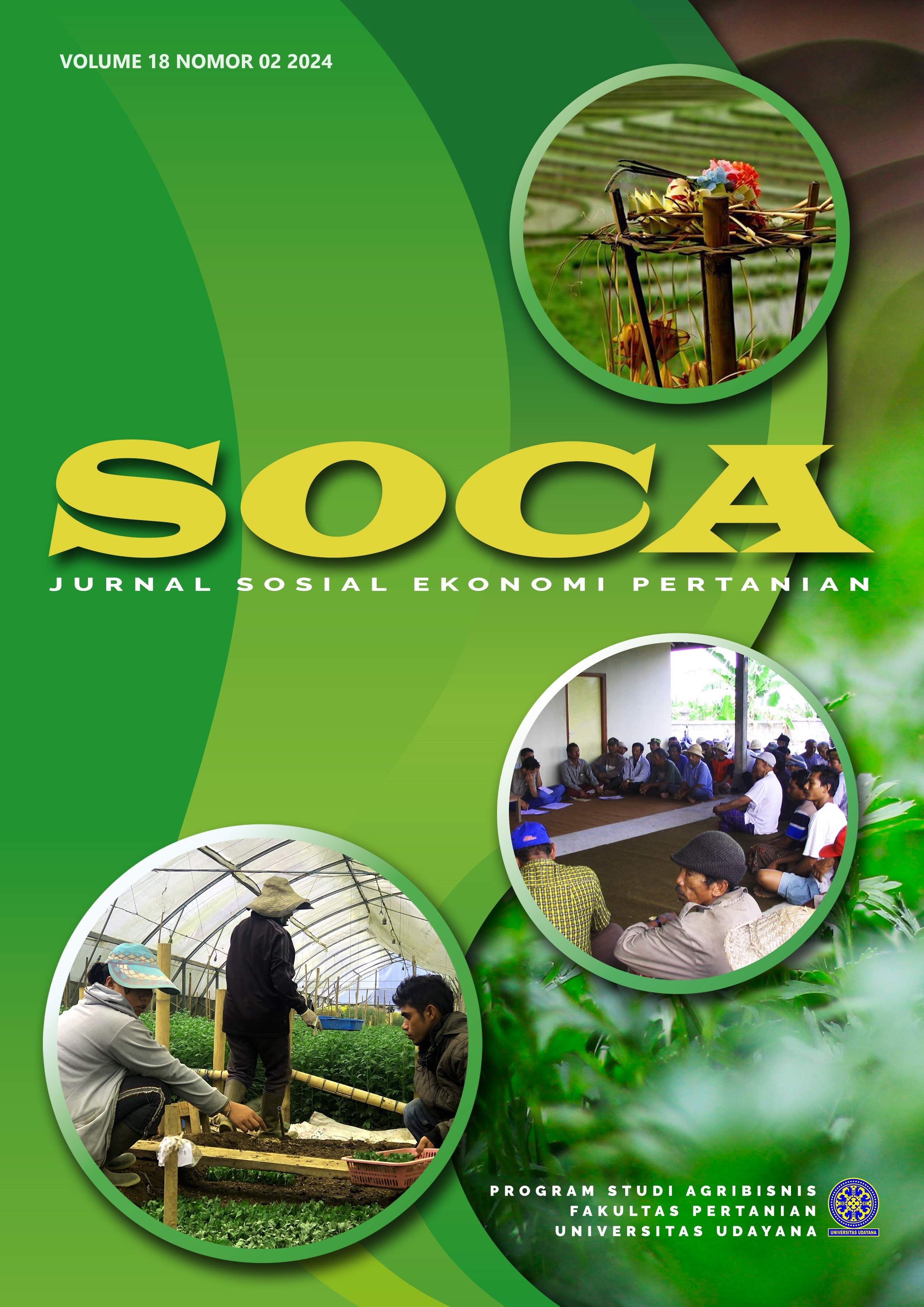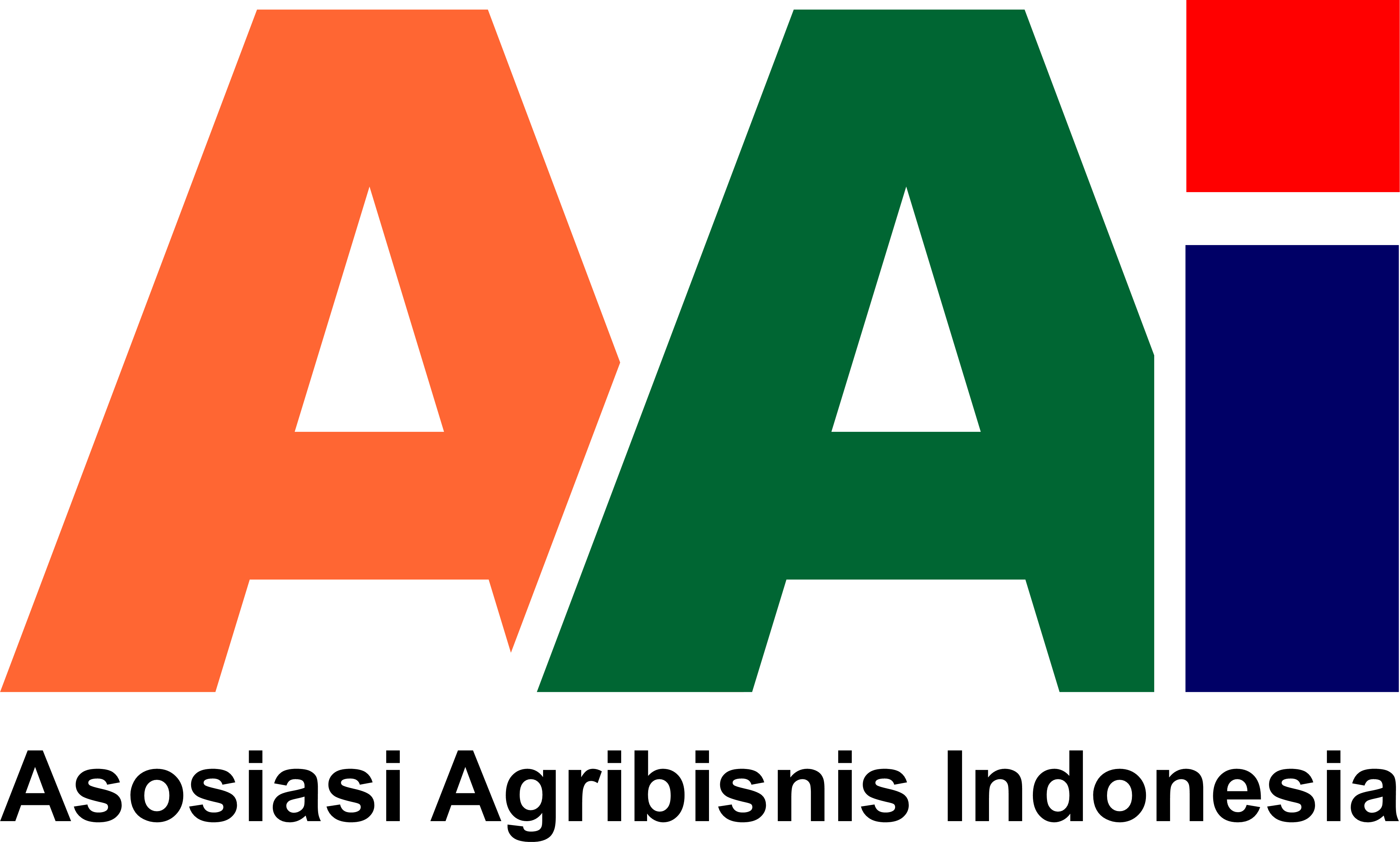The Competitiveness of Indonesian Natural Rubber in World Trade on the Agreed Export Tonnage Scheme Policy
Abstract
The agricultural sector, particularly natural rubber commodities, is
experiencing rapid development, especially in Indonesia, the biggest
producing nation for rubber worldwide. A product is considered
competitive if it can compete effectively in the market. High
competitiveness in a product is reflected in its good price and
quality. However, if a product cannot compete, it will lead to new
problems. Therefore, various analyses, such as the competitiveness
analysis of Indonesian natural rubber, are necessary. This research
aims to analyze the competitiveness of Indonesian natural rubber
and explain the factors influencing this competitiveness. Annual
data from 2000 to 2002 was collected from the Food and Agriculture
Organization of the United Nations, the World Bank, the World Trade
Organization, the Ministry of Agriculture of the Republic of
Indonesia, and the Ministry of Trade of the Republic of Indonesia. A
quantitative approach using the Ordinary Least Squares (OLS)
method is employed. The research is conducted in Indonesia due to
its status as one of the countries with the highest natural rubber
production value globally. The analysis tools used include Microsoft
Excel and SPSS 28.0.1.0. The results of the competitiveness analysis
indicate that Indonesian natural rubber farming has a competitive
advantage in world trade. Of the four factors affecting
competitiveness, only Indonesia's natural rubber production shows
significance, while the exchange rate, export value, and policies do
not have a significant impact
Downloads
References
Aisyah, S. M., Yusa, M. Y., Supli, N. A., & Ikhsan, O. K. M. F. (2021). The Implementation of South Sumatera Downstream Industry for Rubber Product Strategic Policy with The Establishment of Tanjung Api-Api Special Economic Zone. Jurnal Hubungan Internasional, 10(1), 1–18. https://doi.org/10.18196/hi.v10i1.10791
Anwar, C. (2017). The Role of the International Tripartite Rubber Council (TRC) in Stabilizing Natural Rubber Prices. Proceedings of International Rubber Conference, 1–16. https://doi.org/https://doi.org/10.22302/ppk.procirc2017.v1i1.516
Ardanari, S. D., & Mukiwihando, R. (2020). Daya Saing Ekspor Karet Alam Tiga Negara ITRC (Indonesia, Thailand, Malaysia) Di Pasar Internasional Periode 1994-2018. Journal of Public Financial Management, 4(1), 81–87. https://doi.org/https://doi.org/10.31092/jmkp.v4i1.806
Arifin, B. (2005). Supply Chain of Natural Rubber in Indonesia. Jurnal Manajemen & Agribisnis, 2(1), 1–16. https://doi.org/https://doi.org/10.17358/jma.2.1.1-16
Balassa, B. (1965). Trade Liberalisation and “Revealed” Comparative Advantage. The Manchester School, 33(2), 99–123.
Bajgar, M. & Javorcik, B. (2020). Climbing the Rungs of the Quality Ladder: FDI and Domestic Exporters in Romania, The Economic Journal, 130(628), 937-955. https://doi.org/10.1093/ej/ueaa003
Bashir, S., Khwaja, M. G., Rashid, Y., Turi, J. A., & Waheed, T. (2020). Green Brand Benefits and Brand Outcomes: The Mediating Role of Green Brand Image. SAGE Open, 10(3). https://doi.org/10.1177/2158244020953156
Bojnec, Š., & Ferto, I. (2015). Agri-Food Export Competitiveness in European Union Countries. Journal of Common Market Studies, 53(3), 476–492. https://doi.org/10.1111/jcms.12215
Cahyaningtyas, I., Utami, A. W., & Waluyati, L. R. (2022). Indonesia’s Natural Rubber Productivity and Technically Specified Natural Rubber 20 Export: The Effect of El Nino Southern Oscillation. Agraris, 8(2), 215–230. https://doi.org/10.18196/agraris.v8i2.14320
Cantwell, J. (1989). Technological Innovation and Multinational Corporations. B. Blackwell.
Dalum, B., Laursen, K., & Villumsen, G. (1998). Structural change in OECD export specialisation patterns: de-specialisation and “stickiness.” International Review of Applied Economics, 12(3), 423–443. https://doi.org/10.1080/02692179800000017
Daulika, P., Peng, K.-C., & Hanani, N. (2020). Analysis on Export Competitiveness and Factors Affecting of Natural Rubber Export Price in Indonesia. Agricultural Social Economic Journal, 20(1), 39–44. https://doi.org/10.21776/ub.agrise.2020.020.1.6
Dick, J. S., Harmon, C., & Vare, A. (1999). Quality assurance of natural rubber using the rubber process analyzer 1. In Polymer Testing (Vol. 18).
Fatahillah, Andriyani, D., Rahmah, M., & Syafirah, S. (2022). Effect of Rubber Production, Dollar Exchange Rate and Inflation on Rubber Exports in Indonesia. Journal of Malikussaleh Public Economics, 5(1), 1–8. https://doi.org/https://doi.org/10.29103/jmpe.v5i1.8134
Ha, M. T. (2021). Optimizing Green Brand Equity: The Integrated Branding and Behavioral Perspectives. SAGE Open, 11(3). https://doi.org/10.1177/21582440211036087
Hanivia, S. R., & Suprehatin, S. (2022a). Agriecobis (Journal of Agricultural Socioeconomics and Business) The Effect of Agreed Export Tonnage Scheme (AETS) Policy on Indonesia’s Natural Rubber Exports to Japan. Journal of Agricultural Socioeconomics and Business, 5(1), 12–21. https://doi.org/10.22219/agriecobis
Hanivia, S. R., & Suprehatin, S. (2022b). Agriecobis (Journal of Agricultural Socioeconomics and Business) The Effect of Agreed Export Tonnage Scheme (AETS) Policy on Indonesia’s Natural Rubber Exports to Japan. Journal of Agricultural Socioeconomics and Business, 5(1), 12–21. https://doi.org/10.22219/agriecobis
Hidayah, H., Suyatno, A., & Kurniati, D. (2021). The Competitiveness Analysis of Corn Farming on Peatland. SOCA: Jurnal Sosial Ekonomi Pertanian. 15(3), 470-481. https://doi.org/10.24843/SOCA.2021.v15.i03.p05
Hinloopen, J., & Charles, V. M. (2001). On the empirical distribution of the Balassa index. Weltwirtschaftliches Archiv, 137(1), 1–35.
Hoang, V. Van. (2020). Investigating the agricultural competitiveness of ASEAN countries. Journal of Economic Studies, 47(2), 307–332. https://doi.org/10.1108/JES-10-2018-0366
James, W. E., & Movshuk, O. (2003). Comparative advantage in Japan, Korea, and Taiwan between 1980 and 1999: testing for convergence and implications for closer economic relations. The Developing Economies, 41(3), 287–308.
Kamaluddin, Rumbiati. (2018). Competitiveness and Exports Sustainability of the Indonesian Natural Rubber. Sriwijaya International Journal of Dynamic Economics and Business. 2(1), 85-98. https://doi.org/10.29259/sijdeb.v2i1.%p
Kementerian Pertanian. (2023). Analisis Kinerja Perdagangan Karet. Pusat Data dan Sistem Informasi Pertanian.
Kopp, T., Dalheimer, B., Alamsyah, Z., Yanita, M., & Brümmer, B. (2019). Can the Tripartite Rubber Council manipulate international rubber prices? In EFForTS Discussion Paper Series (Issue 30). EFForTS Discussion Paper Series, GOEDOC, Dokumenten- und Publikationsserver der Georg-August-Universität. https://nbn-resolving.de/urn:nbn:de:gbv:7-webdoc-3995-6
Kuncoro, M. (2009). Metode Riset Untuk Bisnis dan Ekonomi (3rd ed.). Erlangga.
Lisdiani, I., Nikensari, S. I., & Irianto, D. (2021). The Effect of Exchange Rate, Consumption, and GDP on Indonesian Rubber Exports by Main Destination Country. Jurnal Pendidikan Ekonomi Perkantoran Dan Akuntansi, 7(2), 101–111. https://doi.org/10.21009/JPEPA.007.x.x
Masliani. (2020). Changes in The Price of Rubber Sheets at The Farmer Level and Factory Level in Central Kalimantan. International Journal of Management, 11(5), 920–928. https://doi.org/10.34218/IJM.11.5.2020.084
Nekmahmud, M., & Fekete-Farkas, M. (2020). Why not green marketing? Determinates of consumers’ intention to green purchase decision in a new developing nation. Sustainability (Switzerland), 12(19), 1–31. https://doi.org/10.3390/su12197880
Nugroho, A. D., Prasada, I. Y., & Lakner, Z. (2022). Performance and Forecast of Indonesian Rubber Exports to The Central European Countries. OISAA Journal of Indonesia Emas , 5(1), 66–81. https://doi.org/https://doi.org/10.52162/jie.2022.005.01.8
Nurdina, A., Harmini, & Rifin, A. (2021). The Effect of Export Quotas on Indonesia’s Domestic Natural Rubber Prices. Buletin Ilmiah Litbang Perdagangan, 15(2), 257–276. https://doi.org/10.30908/bilp.v15i2.609
Nursodik, H., Santoso, S. I., & Nurfadillah, S. (2022). Competitiveness of Indonesian Tea Export in Southeast Asia Markets. SOCA: Jurnal Sosial Ekonomi Pertanian, 16(1), 1-14. https://doi.org/https://doi.org/10.24843/SOCA.2022.v16.i01.p01
Pramananda, P. P., Rifin, A., & Nauly, D. (2022). The Effect of Domestic Consumption on Natural Rubber Farmgate Price in Indonesia. AGRARIS: Journal of Agribusiness and Rural Development Research, 8(2), 248–260. https://doi.org/10.18196/agraris.v8i2.12480
Prasada, I. Y., & Dhamira, A. (2022). Non-Tariff Measures and Competitiveness of Indonesia’s Natural Rubber Export in Destination Countries. Agraris, 8(2), 181–197. https://doi.org/10.18196/agraris.v8i2.11392
Prasada, I. Y., Nugroho, A. D., & Lakner, Z. (2022). Impact of the FLEGT license on Indonesian plywood competitiveness in the European Union. Forest Policy and Economics, 144. https://doi.org/10.1016/j.forpol.2022.102848
Priyadi, Y. F. A., Hani, E. S., & Saito, Y. (2022). Partnership Impact on Production and Income of Indonesia Rubber Farmers. Economics Development Analysis Journal, 3(22), 381–393. https://doi.org/https://doi.org/10.15294/edaj.v11i3.54316
Purnomowati, H. D., Darwanto, D. H., Widodo, S., & Hartono, S. (2015). Analisis Permintaan Karet Alam Indonesia di Pasar Internasional. AGRARIS: Journal of Agribusiness and Rural Development Research, 1(2), 136–148. https://doi.org/10.18196/agr.1217
Raihanisyah, R. (2017). Analisis Daya Saing Ekspor Karet Alam Indonesia di Pasar Dunia. Jurnal Ilmu Ekonomi Pertanian Indonesia. 8(1), 95-108. http://dx.doi.org/10.31258/ijae.8.1.95-108
Ramli, N. (2019). Rubber Price Volatility and Inequality in Economic Development. In Issues and Challenges in the Malaysian Economy (pp. 79–93). Emerald Publishing Limited. https://doi.org/https://doi.org/10.1108/978-1-83867-479-320191006
Sadikin, I. & Irawan, R. (2006). Dampak Pembangunan Perkebunan Karet-Rakyat Terhadap Kehidupan Petani di Riau. SOCA: Jurnal Sosial Ekonomi Pertanian, [S.l.], nov. 2012. ISSN 2615-6628. Available at:
Sari, D. K., Supriana, T., & Rahmanta. (2021). Determinant Factors of Indonesian Rubber Export to Japan. IOP Conference Series: Earth and Environmental Science, 782(2). https://doi.org/10.1088/1755-1315/782/2/022053
Siddique,A. & Vlassopoulos, M. (2020). Competitive Preferences and Ethnicity: Experimental Evidence from Bangladesh. The Economic Journal. 130 (627), 793–821. https://doi.org/10.1093/ej/uez063
Silaban, E.P.K., Satmoko, S., Prayoga, K. (2021). The Livelihood Strategy of Rubber Tapper Households. SOCA: Jurnal Sosial Ekonomi Pertanian, 15(3), 427 – 438. https://doi.org/10.24843/SOCA.2021.v15.i03.p01.
Septa Pratama, Adi Putra, & Hasan Basri, H. B. (2022). Independent and Dependent Variable: Influence on Jambi Province Rubber Exports. Jurnal Prajaiswara, 3(2), 116–125. https://doi.org/10.55351/prajaiswara.v3i2.50
Suri, T. N., Rahmanta, & Wibowo, R. P. (2021). Analysis of Affecting Factors on the Natural Rubber Exports Volume in North Sumatera. Indonesian Journal of Agricultural Research, 4(1), 58–64. https://doi.org/10.32734/injar.v4i1.4584
Syahrudin, S., Wahyudi, H., Ciptawaty, U. (2022). Analisis Daya Saing Karet Alam Indonesia di Pasar Internasional. BULLET: Jurnal Multidisiplin Ilmu. 1(6), 1302-1310.
Usman, M., Wardhana, M. Y., & Istiqamah, M. (2022). Analysis of the Risk of Rubber Prices Using the ARCH-GARCH and VaR Methods on Farm Income in West Aceh District. International Journal on Advanced Science Engineering Information Technology, 12(3), 1018–1022. https://doi.org/https://doi.org/10.18517/ijaseit.12.3.13637
Van Hoang, V., Tran, K. T., Van Tu, B., Nguyen, V. N., & Nguyen, A. Q. (2017). Agricultural competitiveness of vietnam by the RCA and the NRCA Indices, and consistency of competitiveness indices. Agris On-Line Papers in Economics and Informatics, 9(4), 53–67. https://doi.org/10.7160/aol.2017.090406
Virginia, A., & Novianti, T. (2020). Non-Tariff Measures (NTMS) and Indonesian Natural Rubber Export to The Main Export Destination Countries. Journal of Developing Economies, 5(1), 57. https://doi.org/10.20473/jde.v5i1.18609
Widyantari, K. L., & Setiawina, N. D. (2021). Analysis The Influence Of Amount Domestic Production, Exchange Rate And Price On Rubber Export Value In Indonesia, 2015-2019. IJISET-International Journal of Innovative Science, Engineering & Technology, 8(1), 289–293. www.bi.go.id,
Yanita, M., Yazid, M., Alamsyah, Z., & Mulyana, A. (2016). Determinant Analysis for Rubber Export in Indonesia. International Journal of Scientific and Research Publications, 6(9), 478–481. http://www.ijsrp.org/research-paper-0916.php?rp=P575808
Zainuddin, Sinaga, B. M., Hartoyo, S., & Erwidodo. (2019). The Impact of Import Tariff Reduction, Investment and Rellocation of Tire Industries on Indonesian’s Natural Rubber and Tire Trade in the World Market. Buletin Ilmiah Litbang Perdagangan, 13(1), 71–98. https://doi.org/https://doi.org/10.30908/bilp.v13i1.341
Zainuddin, Z. (2022). Import demand potential for Indonesian rubber products in ASEAN countries. Jurnal Perspektif Pembiayaan Dan Pembangunan Daerah, 10(2), 75–90. https://doi.org/10.22437/ppd.v10i2.14561
Zuhdi, F., & Anggraini, R. S. (2020). The Indonesian Natural Rubber Export Competitiveness in Global Market. International Journal of Agriculture System, 8(2), 130–139. https://doi.org/10.20956/ijas.v8i2.2518













